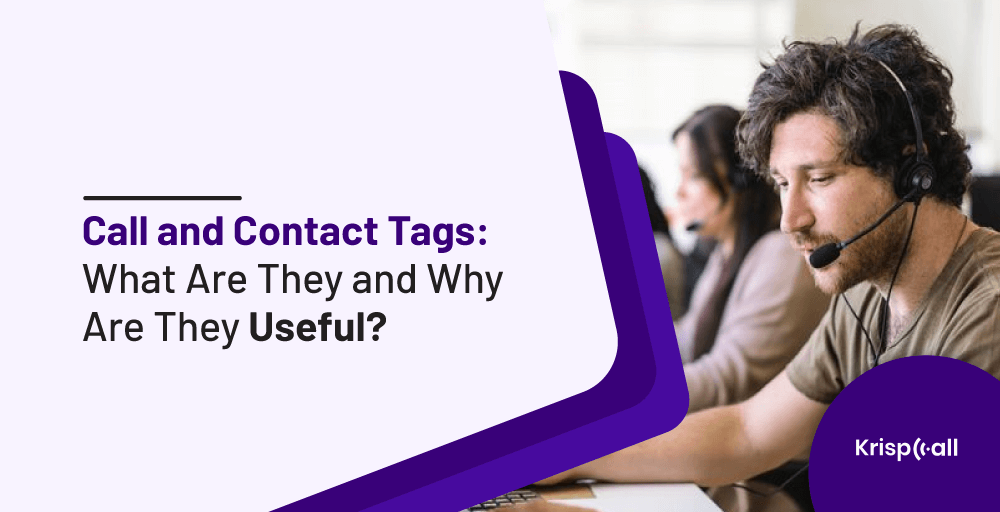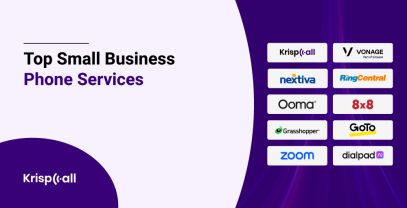Are you having problems identifying your customer’s calls and contacts? Well, the cloud telephony system has something ingenious called Call tags and Contact tags that will assist you to eliminate such trouble.
The concept of call tags and contact tagging is very straightforward. They focus on arranging your calls and contacts into clusters by giving them tags. These simple yet genius features make your workload a hundred times more organized by helping you and your agents identify any calls or contacts.
About 70% of interaction between customers and agents occurs through phone calls in the cloud-based call center.
So, there is no surprise that customers look forward to a quality customer service experience. And using call tags and contact tagging, agents will know exactly how to deal with each customer on the basis of their tags.
Let’s take a closer look at this article to understand more about them.
What are Call tags?
Call tags allow you to give a custom tag to each inbound or outbound call which assists in sorting calls into different categories. It gives an agent a quick perspective to identify the type of call. Call Tags in shipping is a type of label that is used to reclaim things from a person.
Call tags are general values that enable you to identify a phone call with a specific response. Anyone on your team can swiftly gather an outline of the call by using call tags instead of going through the call notes or other information. You can also quickly filter and export calls based on a specific tag.
Each call can have an unlimited amount of tags assigned to it. These tags can be used to describe what customers have to say about your product or customer service.
Also, they can be used to remind you of pending internal activities, such as calling a customer back for an appointment or informing them that their request has been followed upon. Certain tags can even be pre-set and added to calls with just one click.
What are Contact tags?
Contact tagging allows you to label tags to each contact which assists in organizing contact information. It gives you an idea of distinguishing contacts among VIP clients, prospects, business owners, etc. It helps you to quickly identify what type of contact you are working with.
It assists you to create contact groups for categorization and send customized messaging to each contact. You may categorize your contacts based on where they came from, which form they filled out, what product they bought, and many other factors.
Multiple tags can be attached with contact which makes it easier to organize them. This allows you to quickly search your database for specific groupings of contacts.
Contact tags can be personal. Personal information, such as a birthday or sign-up anniversary, can be added to contacts. This information allows you to interact with customers in a more personal fashion, such as sending them a special offer on their birthday or sign-up anniversary.
👉 Also Read More About: Top Call Center Trends
Why use Call and Contact tags?
Call and contact tags make business communication easy by giving a custom identity to calls and contacts. They may look like a gimmick to attract businesses but they deliver understated benefits to improve business quality. Here are some amazing reasons for using these features.
9 reasons for using Call and Contact tags
1. Arrange calls and contacts
The upfront reason for using these tags is to arrange calls and contacts in a particular order. This sort of arrangement allows teams to distinguish the type of call or contacts so that teams can analyze them to improve sales processes.
Every tag can be categorized according to the outcome of the call and customer behavior. You can assign predefined tags to quickly put on a tag.
It is easier to determine what conversation went through between an agent and a customer/client just by viewing the tags. This helps agents to quickly take necessary actions based on these tags.
2. Recognize quality leads
Your marketing team can filter assigned tags to list potential leads for your business. Marketing teams can use tags to fine-tune their plans and judge the quality of filtered leads.
A recent survey suggests that an agent makes an average of 18 calls before making contact with a potential customer. Ultimately, it makes more sense to use tagging to determine your current status with a particular customer.
Leads can come from different sources such as email campaigns, advertisements, etc. Without tagging, you would not know from where your leads are coming. This information is important because tagging helps you to recognize which sources are generating hot leads and which are generating cold leads.
3. Make a winning strategy
Businesses have to go through different types of strategies to come up with a really good strategy to increase their sales. You don’t have to go through extensive research to know why you are not making good sales.
By simply tagging a call and contact, you can know the reason behind why customers didn’t make any purchase.
These call and contact tags help you to pinpoint what is attracting your customers to your products. Such tags are used as guiding lines while approaching potential leads. You can lead your marketing team for building a strategy to structure strong phone call scripts.
👉 Read More About: How do contact tags help in navigation
4. Create an ideal target audience profile
While running a business, it is extremely important to know your target audience. They are your potential leads who will be interested to use your product. All you need is to tag all your calls and contacts to identify who your target audience is.
Your targets will give information during the calling session. During the conversation, agents can gather key points which should be tagged. You will accumulate various types of tags. These tags are analyzed thoroughly by the marketing team to create the profile of your target audience.
5. Reduce lead leakage
There is always a possibility to lose important leads that fall out from the pipeline. Even if your system is properly automated, some human errors can disrupt the proper flow of the sales process of your business.
Call and contact tagging can help you to lead leakage. You can keep track of important calls and contacts by tagging them properly (for example priority lead, hot lead, etc.). These allow you to manually search such tags and you will be able to catch any lead that could have leaked without a tag.
6. Spot sales barriers
Each lead that does not result in a sale should be acknowledged. Tag these leads with the reason indicating why the sales didn’t go through. So that you will adjust your sales process to improve sales performance.
There can be many reasons why your leads didn’t buy your products. It could be because your product was expensive, missing features, low quality, or many others. Use these keywords as the tag to identify such leads.
These tags should provide you some ideas on how to design your own custom tagging system tailored to your company’s needs, so you can accurately measure why leads don’t buy from you.
7. Improve employee productivity
Tags aren’t just used to highlight customer’s calls. They can be also used to rate your employee. Whenever your employee handles a call to make a great sales or gave an excellent customer service experience, that call can get a tag praising your employee.
For example, tags can read as excellent customer service’, ‘great sales close’, or anything that describes your employee performance.
This allows you to measure the quality of capability of your agent and use those tags as guiding lines to improve employee productivity in your company. Also, it assists you to measure the sales process and call quality.
👉 You May Also Like: Best Ways To Improve Call Center Productivity
8. Comparisons with competitors
Customers often compare products with other competitors on the phone. This is a great opportunity to know your product’s strong points and weak points against competitors’ products.
During a phone call, customers can compare one or more elements of your business or product with competitors. You can tag the competitor’s name along with the element compared by the customers.
You can observe how your customers compare you to your competition once the call tags are put together. This isn’t based on assumptions or extensive research. It is based on real-time feedback from the customer.
9. Re-marketing products
While interacting with leads on the phone, your agents can come across different reasons why customers aren’t interested in your products, why your product is not doing well in the market, or why customers aren’t returning after one purchase or more.
Tagging these reasons to the call and contact is important to make a better marketing strategy for the product. It assists your team to remarket your products to the customers as per their needs to improve the sales process. It allows you to make changes in your product to match with elements that the market demands.
Conclusion
Call and contact tags are the easiest and quickest way to understand each type of call and contact. They may seem like a small block of words but they play an important role in interacting with customers. Any agent and marketing team of a company are more than delighted to have such to-the-point information to make a business strategy.





